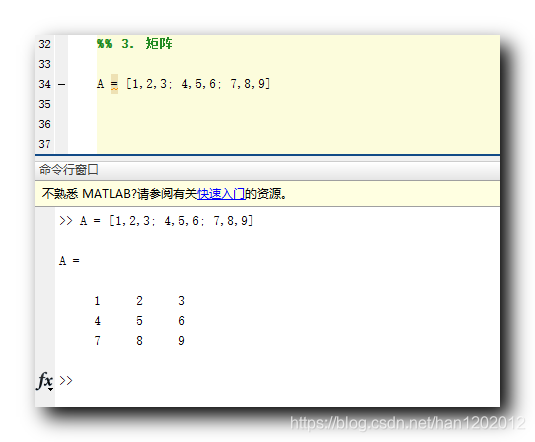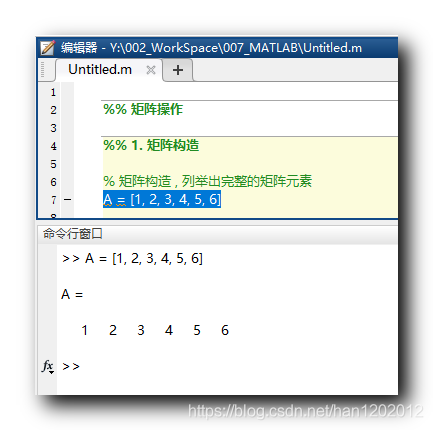显示包含复数的cvMatrix (CV_64FC2)
我是OpenCV新手,我想将python程序的结果与我在OpenCV中的计算结果进行比较。我的矩阵包含复数,因为它是cvDFT的结果。Python可以很好地处理复数,并用科学记数法显示它。我的C++程序在尝试使用std::cout时无效。
我试图将我的numbers数组存储在std::complex[]中,而不是double[]中,但是它不能编译。
下面是我的代码,以及它的结果:
CvMat *dft_A;
dft_A = cvCreateMat(5, 5, CV_64FC2); // complex matrix
double a[] = {
0, 0, 0, 0, 0,
1, 1, 1, 1, 1,
2, 2, 2, 2, 2,
3, 3, 3, 3, 3,
4, 4, 4, 4, 4
};
dft_A->data.db = a;
std::cout << "before : " << a[0] << std::endl;
cvDFT( dft_A, dft_A, CV_DXT_FORWARD); // DFT !
std::cout << "after : " << a[0] << std::endl;
>> before : 0以下是python中的相同内容,输出如下:
>>> a = np.mgrid[:5, :5][0]
>>> a
array([[0, 0, 0, 0, 0],
[1, 1, 1, 1, 1],
[2, 2, 2, 2, 2],
[3, 3, 3, 3, 3],
[4, 4, 4, 4, 4]])
>>> np.fft.fft2(a)
array([[ 50.0 +0.j , 0.0 +0.j , 0.0 +0.j ,
0.0 +0.j , 0.0 +0.j ],
[-12.5+17.20477401j, 0.0 +0.j , 0.0 +0.j ,
0.0 +0.j , 0.0 +0.j ],
[-12.5 +4.0614962j , 0.0 +0.j , 0.0 +0.j ,
0.0 +0.j , 0.0 +0.j ],
[-12.5 -4.0614962j , 0.0 +0.j , 0.0 +0.j ,
0.0 +0.j , 0.0 +0.j ],
[-12.5-17.20477401j, 0.0 +0.j , 0.0 +0.j ,
0.0 +0.j , 0.0 +0.j ]])
>>>问题显然来自第二个cout,它对date类型(复数的CV_64FC2)的效率很低。
我的问题是:我如何转储结果,以便我可以检查我的python代码是否与我的cpp/opencv代码执行相同的操作?
谢谢!
回答 2
Stack Overflow用户
发布于 2010-02-14 18:13:58
在OpenCV 2.0代码中有一个dft示例,我现在也在研究它。这里有一个拷贝粘贴给你,它可能会给你一个想法。正如您所看到的,它使用cvSplit将其扩展为实部和虚部。希望这能有所帮助:
im = cvLoadImage( filename, CV_LOAD_IMAGE_GRAYSCALE );
if( !im )
return -1;
realInput = cvCreateImage( cvGetSize(im), IPL_DEPTH_64F, 1);
imaginaryInput = cvCreateImage( cvGetSize(im), IPL_DEPTH_64F, 1);
complexInput = cvCreateImage( cvGetSize(im), IPL_DEPTH_64F, 2);
cvScale(im, realInput, 1.0, 0.0);
cvZero(imaginaryInput);
cvMerge(realInput, imaginaryInput, NULL, NULL, complexInput);
dft_M = cvGetOptimalDFTSize( im->height - 1 );
dft_N = cvGetOptimalDFTSize( im->width - 1 );
dft_A = cvCreateMat( dft_M, dft_N, CV_64FC2 );
image_Re = cvCreateImage( cvSize(dft_N, dft_M), IPL_DEPTH_64F, 1);
image_Im = cvCreateImage( cvSize(dft_N, dft_M), IPL_DEPTH_64F, 1);
// copy A to dft_A and pad dft_A with zeros
cvGetSubRect( dft_A, &tmp, cvRect(0,0, im->width, im->height));
cvCopy( complexInput, &tmp, NULL );
if( dft_A->cols > im->width )
{
cvGetSubRect( dft_A, &tmp, cvRect(im->width,0, dft_A->cols - im->width, im->height));
cvZero( &tmp );
}
// no need to pad bottom part of dft_A with zeros because of
// use nonzero_rows parameter in cvDFT() call below
cvDFT( dft_A, dft_A, CV_DXT_FORWARD, complexInput->height );
cvNamedWindow("win", 0);
cvNamedWindow("magnitude", 0);
cvShowImage("win", im);
// Split Fourier in real and imaginary parts
cvSplit( dft_A, image_Re, image_Im, 0, 0 );
// Compute the magnitude of the spectrum Mag = sqrt(Re^2 + Im^2)
cvPow( image_Re, image_Re, 2.0);
cvPow( image_Im, image_Im, 2.0);
cvAdd( image_Re, image_Im, image_Re, NULL);
cvPow( image_Re, image_Re, 0.5 );
// Compute log(1 + Mag)
cvAddS( image_Re, cvScalarAll(1.0), image_Re, NULL ); // 1 + Mag
cvLog( image_Re, image_Re ); // log(1 + Mag)Stack Overflow用户
发布于 2010-01-22 16:19:46
你有没有尝试过OpenCV的python绑定?http://www.exothermia.net/monkeys_and_robots/2009/12/11/working-opencv-python-bindings/
通过绑定,您可以从python中调用OpenCV函数,并将结果作为numpy数组,然后将它们与纯python代码中的结果进行比较。通过一些修补,您可以包装自己的C代码,并使其在python中也可用。
但是如果你只想转储数据,你可以将真实的和虚构的部分保存为图像并在python中读取它们(我对OpenCV不是很熟悉,你必须检查它对浮动图像的支持-以及python的支持)。
https://stackoverflow.com/questions/2048577
复制














